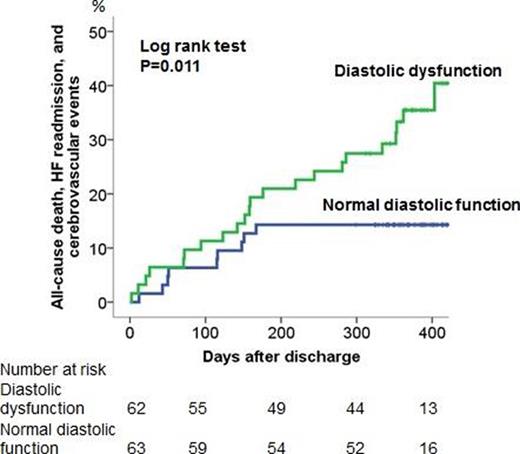-
Views
-
Cite
Cite
B Oeun, S Hikoso, T Yamada, Y Yasumura, M Uematsu, H Abe, Y Nakagawa, Y Higuchi, H Fuji, T Mano, D Nakatani, T Kitamura, T Kojima, H Kida, Y Sakata, The OCVC Investigators, P4549
Comparison of characteristics and prognosis of heart failure patients with preserved ejection fraction with diastolic dysfunction and normal diastolic function, European Heart Journal, Volume 40, Issue Supplement_1, October 2019, ehz745.0940, https://doi.org/10.1093/eurheartj/ehz745.0940Close - Share Icon Share
Abstract
Previous studies showed that some patients with heart failure with preserved ejection fraction (HFpEF) have no visible diastolic dysfunction assessed by echocardiography. There remains limited data on the prognosis of patients with diastolic dysfunction (DD) HFpEF and normal diastolic function (ND) HFpEF.
This study aims to examine the prognostic significance of echocardiographic DD and ND in patients admitted with HFpEF.
We assessed consecutive 127 patients who were registered in the PURSUIT-HFpEF, a prospective multicenter observational study of patients with HFpEF enrolling patients with LVEF ≥50%, and NT-proBNP ≥400 pg/ml on admission. Median age was 82 [interquartile range (IQR): 76–87] years old, and 71.4% were female. The DD group included the patients with at least three of the following four criteria: (1) E/e' >14, (2) septal e' velocity <7 cm/s, (3) tricuspid regurgitation peak velocity >2.8 m/s, (4) left atrial volume index >34 ml/m2. The patients with only one or absent the above criteria were included in the ND group. The primary endpoint was a composite of all-cause death, HF readmission, and cerebrovascular events during one-year follow-up.
63 patients (49.6%) were included in the DD group and 64 patients (50.4%) in the ND group. Patients with DD were significantly older, more likely female, had lower estimated glomerular filtration rate (e-GFR), and had higher NT-proBNP than those with ND. However, the prevalence of hypertension, diabetes mellitus, and previous myocardial infarction were not different between the two groups. During a median follow-up of 363 (IQR: 319–394) days, 33 patients (26%) met the primary endpoint. The primary endpoint occurred more frequently in the DD group than in the ND group (36.5% vs. 15.6%, P=0.007). Kaplan-Meier survival analysis showed that patients with DD had significantly higher cumulative events of the primary endpoint than those with ND, (log rank test P=0.011). After adjusting for covariates, multivariate Cox regression revealed that DD was associated with the primary endpoint (hazard ratio: 2.39, 95% confidence interval: 1.08–5.29, P=0.031).

Kaplan Meier
Patients with HFpEF and DD showed poorer one-year clinical outcomes than those with HFpEF and ND. The presence of DD may be an independent prognostic factor in patients with HFpEF.
Roche diagnostics and FUJIFILM Toyama Chemical
- heart failure, acute
- myocardial infarction
- left ventricular ejection fraction
- hypertension
- tricuspid valve insufficiency
- heart failure, diastolic
- echocardiography
- diabetes mellitus
- heart failure
- glomerular filtration rate
- diastole
- follow-up
- patient readmission
- diagnosis
- patient prognosis
- treatment outcome
- ejection fraction
- prognostic factors
- kaplan-meier survival curve
- cox proportional hazards models
- nt-probnp
- glomerular filtration rate, estimated
- heart failure with preserved ejection fraction
- peak arterial velocity
- left atrial volume





